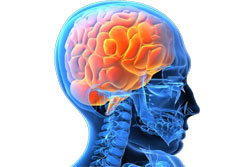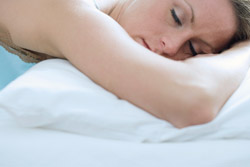- What is myoclonus?
- What causes myoclonus?
- What types of myoclonus are there?
- How is myoclonus diagnosed?
- How is myoclonus treated?
What is myoclonus?
Myoclonus is a term used to describe a broad array of brief and involuntary muscle jerks or “twitches” that originate within the central nervous system. The jerks can occur in many muscles throughout the body and are caused by muscle contractions or lapses in muscle contraction, which are termed positive and negative myoclonus respectively.
The symptoms associated with myoclonus vary greatly between different people. At one end of the scale myoclonus is quite a harmless condition experienced commonly by most people. For example the “jerk” that is experienced in the very early sleep stages is a type of myoclonus, as are the hiccups. At the other end of the scale, myoclonus is associated with more severe muscle contractions that are usually caused by a one of a number of neurological disorders. In other cases myoclonus is not considered a symptom associated with a disease but is considered as a disorder in itself, however this is quite rare.
What causes myoclonus?

Myoclonus is often a symptom associated with the following neurological events and conditions:
- Spinal cord injury;
- Epilepsy;
- Multiple sclerosis;
- Alzheimer’s disease;
- Parkinson’s disease;
- Lipid storage disease;
- Brain tumour;
- Chemical or drug poisoning;
- Complex-region pain syndrome;
- After prolonged oxygen deprivation to the brain (a condition named hypoxia or anoxia);
- Stroke;
- Mitochondrial encephalopathy;
- Heart attack;
- Kidney failure; and
- Liver failure.
What types of myoclonus are there?
The characteristics of myoclonus vary between people with the condition. The different characteristics of the condition which are exhibited can include the following:
- Single or repetitive muscle contractions;
- Involving anywhere from mild to large muscle contractions;
- Contractions that involve either muscles alone or extend to involve both muscles and joints;
- Rare or frequent muscle contractions;
- Muscle contractions experienced as isolated events or frequent patterns;
- Muscle contractions that occur after intentional action or during rest;
- Muscle contractions that occur in response to a known stimulus (predictable) or ones that occur randomly; or
- Regular or irregular muscle contractions.
From this greatly varied expression of myoclonic symptoms it is evident that it is a difficult condition to classify. The first step the neurologist or physical therapist will take in order to classify the condition is to determine the pattern of muscles that are affected. This can be:
- Focal myoclonus: only a very small area, or muscles that are close to each other, are affected;
- Segmental myoclonus: only one or two muscles are affected which are not close to each other (for example the wrist muscles and the thigh muscles);
- Multifocal myoclonus: two or more local areas of muscles which are affected; or
- Generalised myoclonus: widespread muscle contraction.
Myoclonus is then further separated into one of the following categories based on cause:
Physiological myoclonus is the most a common type of myoclonus which often occurs in otherwise healthy people. An example of physiological myoclonus is the hiccups which are caused by myoclonus of the diaphragm. Sleep jerks are also an example of physiological myoclonus;
- Essential myoclonus is often described as a condition in itself as in many cases it does not seem to be associated with any other neurological cause. Essential myoclonus can be inherited and does not appear to worsen over time;
- Progressive myoclonus epilepsy (PME) describes a large and varied group of progressive disorders that involve myoclonus with the main complaint of epilepsy. The group is subdivided according to the presentation of further conditions such as dementia or dystonia and often are accompanied by neurological disturbances in vision, balance or speaking. Most people with PME will have developed the condition in childhood or during adolescence; or
- Symptomatic myoclonus is the classification for myoclonus exhibited as part of the large and diverse array of brain diseases.
Myoclonus can then be further classified according to its specific characteristics and/or associated neurology:
- Action-induced myoclonus is a disabling myoclonus, often expressed in more than one location and worsened by voluntary movement; especially fine, coordinated movements;
- Juvenile myoclonic epilepsy (JME) is a PME that is a common cause of myoclonic and clonic-tonic seizures (body rigidity followed by jerking) in epilepsy. Some people with JME will experience myoclonic seizures as their only seizure type;
- Reticular reflex myoclonus is a subtype of PME. It is generalised epilepsy that originates in the brain stem. The myoclonus is triggered by voluntary or involuntary muscle reflexes;
- Stimulus-sensitive myoclonus describes myoclonus that is specifically triggered by external events. These events may surprise the individual such as a sudden, loud noise or movement;
- Nocturnal/ sleep myoclonus is a very common phenomenon that occurs in the initial sleep stages, known also as “sleep jerks”; or
- Myoclonus on standing is myoclonus that is exhibited when the person is standing, significantly lessening when walking, sitting or lying.
The following are more specific subtypes of myoclonus that are named according to the disease that causes the condition to develop or named after the body part which is affected by the muscle contractions.
- Myoclonus of the diaphragm (hiccups);
- Coeliac-related myoclonus: some people with coeliac disease have myoclonic movements;
- Postanoxic myoclonus: the myoclonus experienced after prolonged oxygen deprivation to the brain;
- Palatal myoclonus: a condition in which rapid contractions of the soft palate (roof of the mouth) persist, sometimes even during sleep. Often other local muscle groups will also be affected such as the face and throat;
- Myoclonus-dystonia is the combination of myoclonic jerks and dystonia. In most cases the myoclonus is the most disabling feature in the condition; and
- Cortical reflex myoclonus is involved in epileptic patients and is characterised by muscle jerks that occur in multiple muscle groups. It is sometimes difficult to distinguish between this form of myoclonus and a multifocal seizure.
Investigators have further suggested that tremors such as jerky tremor and wrist tremor (axterixis) are types of myoclonus however many still believe that these are completely separate symptoms.
- Jerky tremor has many possible causes and is characterised by continuous bursts of muscle activity at the surface of the skin.
- Axterixis describes wrist tremor associated with lapses of muscle contraction, known as negative myoclonus.
How is myoclonus diagnosed?

When myoclonus is part of a broader neurological syndrome the muscle contractions are often milder than if the myoclonus is presented as a disorder in itself. However, all people will exhibit various presentations of the condition; one person may have more regular and milder muscle contractions whereas another person will have irregular but strong muscle contractions.
Once the myoclonus has been classified there are certain diagnoses that can be confused. For example generalised myoclonus that appears to be rhythmic can very easily be confused with tremor; two conditions that can both accompany a neurodegenerative condition but are treated quite differently. A major indicator of myoclonus is non-periodic muscular movements whereas tremor is perfectly rhythmic.
Any myoclonus which is interrupting normal life or causing discomfort should be investigated by a doctor as it may be a symptom of a larger health problem. For example what may appear to be sleep jerks may actually be a symptom of complex sleep disorders that need to be managed accordingly, such as restless leg syndrome.
Muscle activity
Surface electromyography (EMG) will confirm myoclonus. EMG is a technique that allows the activity of a muscle to be measured by placement of electrodes on the skin surface. When the muscle contracts the electrodes capture the intensity of the contraction and this can be visualised graphically on what is specifically termed an electromyograph. Myoclonic contractions will show asymmetric muscle activity bursts. The duration of the contractions is specific to the type of myoclonus exhibited.
Observation
Experienced neurologists will generally need only to observe the muscle contractions of an outstretched arm in order to raise suspicion of myoclonus.
Genetic testing
There is no specific gene mutation that has been identified as a predisposing factor to myoclonus.
How is myoclonus treated?

Myoclonus management is closely related to epilepsy management. Clonazepam is the first-line treatment for myoclonus, other treatments commonly used are levetiractam, phenytoin, valproic acid, primidone or a suitable combination of the latter.
Some antiepileptics will better suit some types of myoclonus, for example levetiracetam is suggested to be the most effective medicine in multifocal cases. Like with any antiepileptic medication regime different people will respond differently to different doses and combinations of the medication and the optimum therapeutic regime will need to be titrated to suit individual cases.
References
- Pappano D, Osborne M. Febrile myoclonus. Pediatric Emergency Care. 2007; 23(9): 649-50. [Abstract]
- Rowland LP. Merrit’s Textbook of Neurology. 7th Ed. Lea & Febiger; Philadelphia: 1984. [Book]
- National Institute of Neurological Disorders and Stroke: Myoclonus Information Page [online]. NINDS, 2010 [cited Feb 2010]. Available from: [URL Link]
- Gerschlager W, Brown P. Myoclonus. Current Opinion in Neurology. 2009; 22 (4): 414-8. [Abstract]
- Roze E, Apartis E, Clot F, et al. Myoclonus-dystonia: clinical and electrophysiologic pattern related to SGCE mutations. Neurology. 2008; 70 (13): 1010-6. [Abstract]
- McKeon A, Pittock SJ, Glass GA, et al. Whole-Body Tremulousness: Isolated Generalized Polymyoclonus. ArchNeurol. 2007; 64(9): 1318-1322 [Full Text]
- Rang HP, Dale MM, Ritter JM, Moore PK. Pharmacology 5th ed. Elsevier Science; London: 2003. [Book]
- Kojovic M, Cordivari C, Bhatia K. Myoclonic disorders: a practical approach for diagnosis and treatment. Ther Adv Neurol Disord. 2011;4(1): 47-62. Available from: [URL Link]
All content and media on the HealthEngine Blog is created and published online for informational purposes only. It is not intended to be a substitute for professional medical advice and should not be relied on as health or personal advice. Always seek the guidance of your doctor or other qualified health professional with any questions you may have regarding your health or a medical condition. Never disregard the advice of a medical professional, or delay in seeking it because of something you have read on this Website. If you think you may have a medical emergency, call your doctor, go to the nearest hospital emergency department, or call the emergency services immediately.








